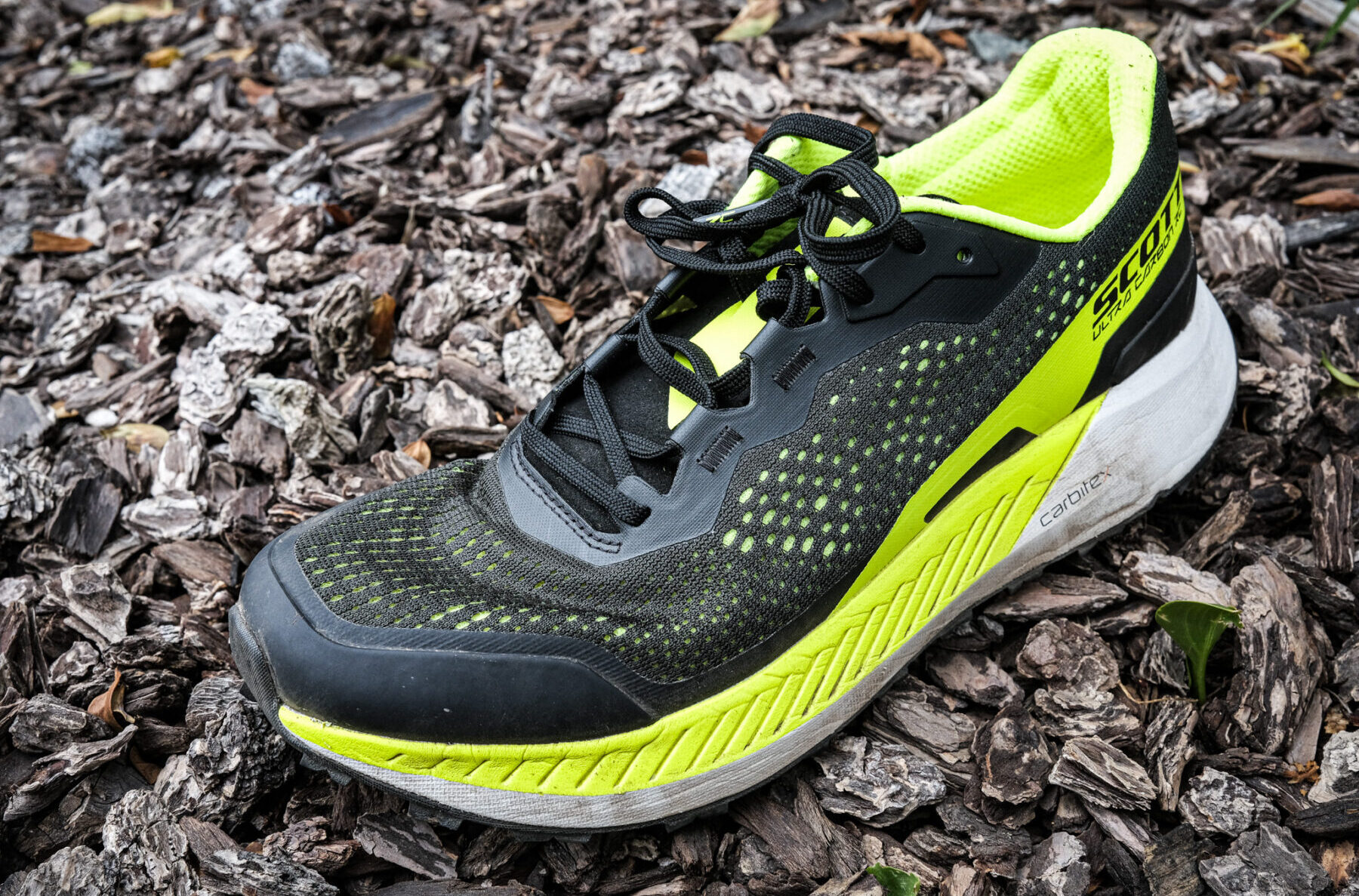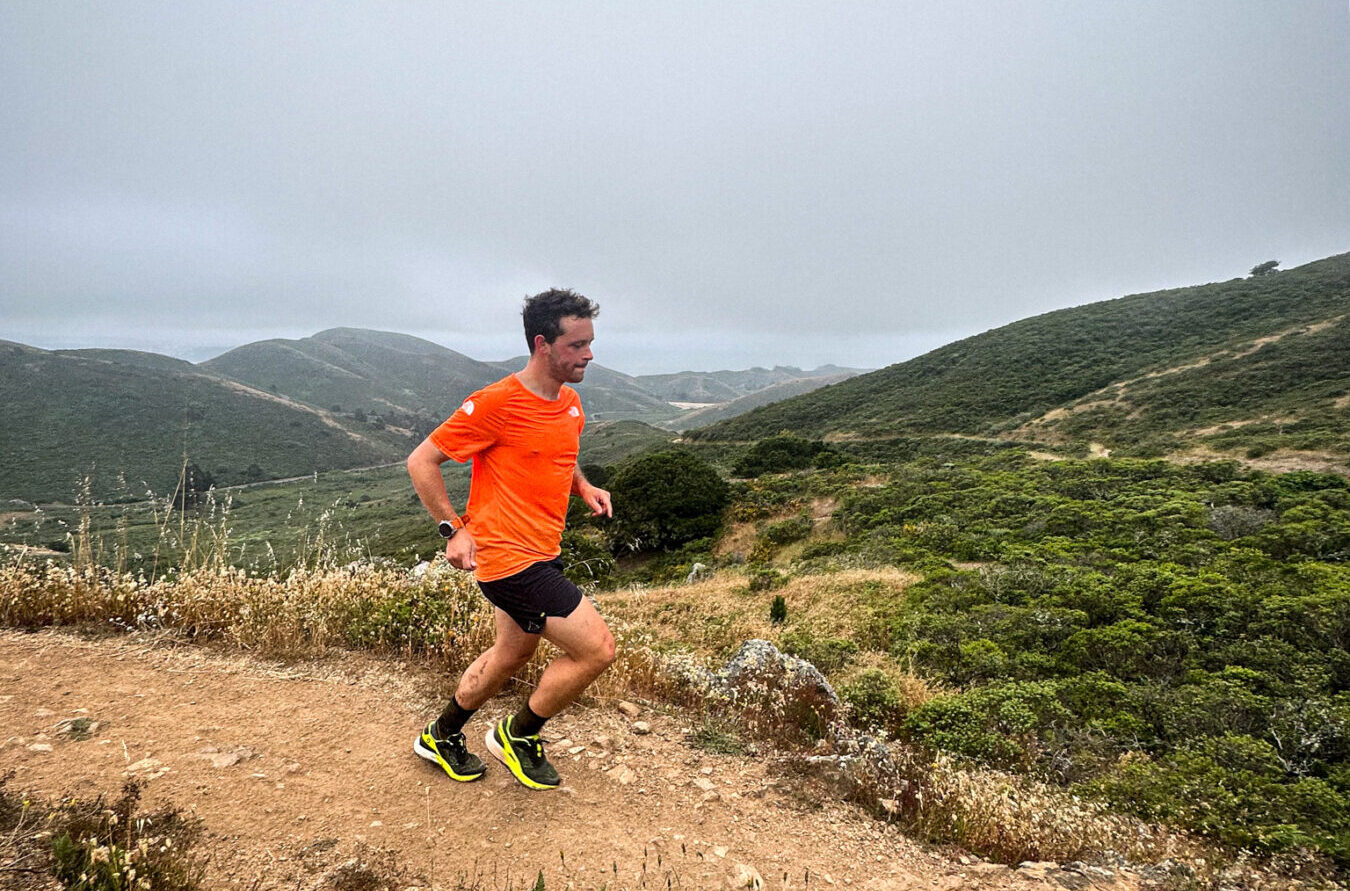Scott Ultra Carbon RC
Test Location: Marin, CA
Test Duration: 40 miles (so far)
Stated Stack Height (Men’s): 25 mm (heel) / 20 mm (forefoot)
Stated Heel-to-Toe Drop: 5 mm
Stated Features:
- Carbitex “GearFlex” performance plate for increased energy return
- “Ultra Traction” outsole
- Dual density “Kinetic” foam midsole
- “Evolved Rocker Technology” for improved running efficiency
- Engineered mesh upper
- Racing footbed
- Toe guard for protection
Stated Weight per Shoe (US Men’s Size 9): 300 g / 10.6 oz
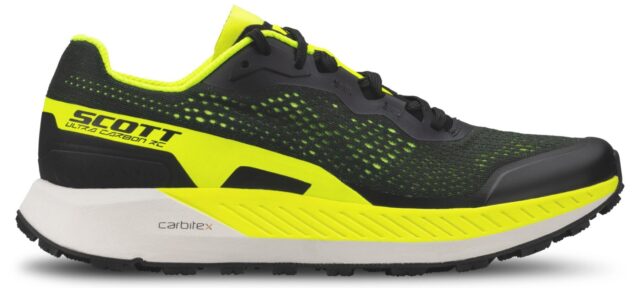
Blister Measured Weight per Shoe (US Men’s Size 8.5):
- Shoes + Laces: 289 g (left) & 290 g (right)
- Insoles: 15 g (left) & 15 g (right)
- Total: g 304 (left) & 305 g (right)
MSRP: $230
Size Tested: US Men’s 8.5 / EU 42
Reviewer: 5’9”, 150 lbs / 175 cm, 68 kg
Intro
Scott has always been at the vanguard of technical development in the outdoor industry, dating back to when they pioneered the aluminum ski pole in the 1950s and aerodynamic handlebars in the late 1980s. With the debut of the Ultra Carbon RC, their first “dynamic carbon plated trail shoe,” they’re hoping to continue that trend in the running space. Though I’ve been outspoken about my skepticism toward performance plates in trail shoes, I decided to give the Ultra Carbon RC a shot, optimistic that Scott could have managed to skirt some of the drawbacks that routinely plague plated models (e.g., instability, inflexibility, and a harsh ride).
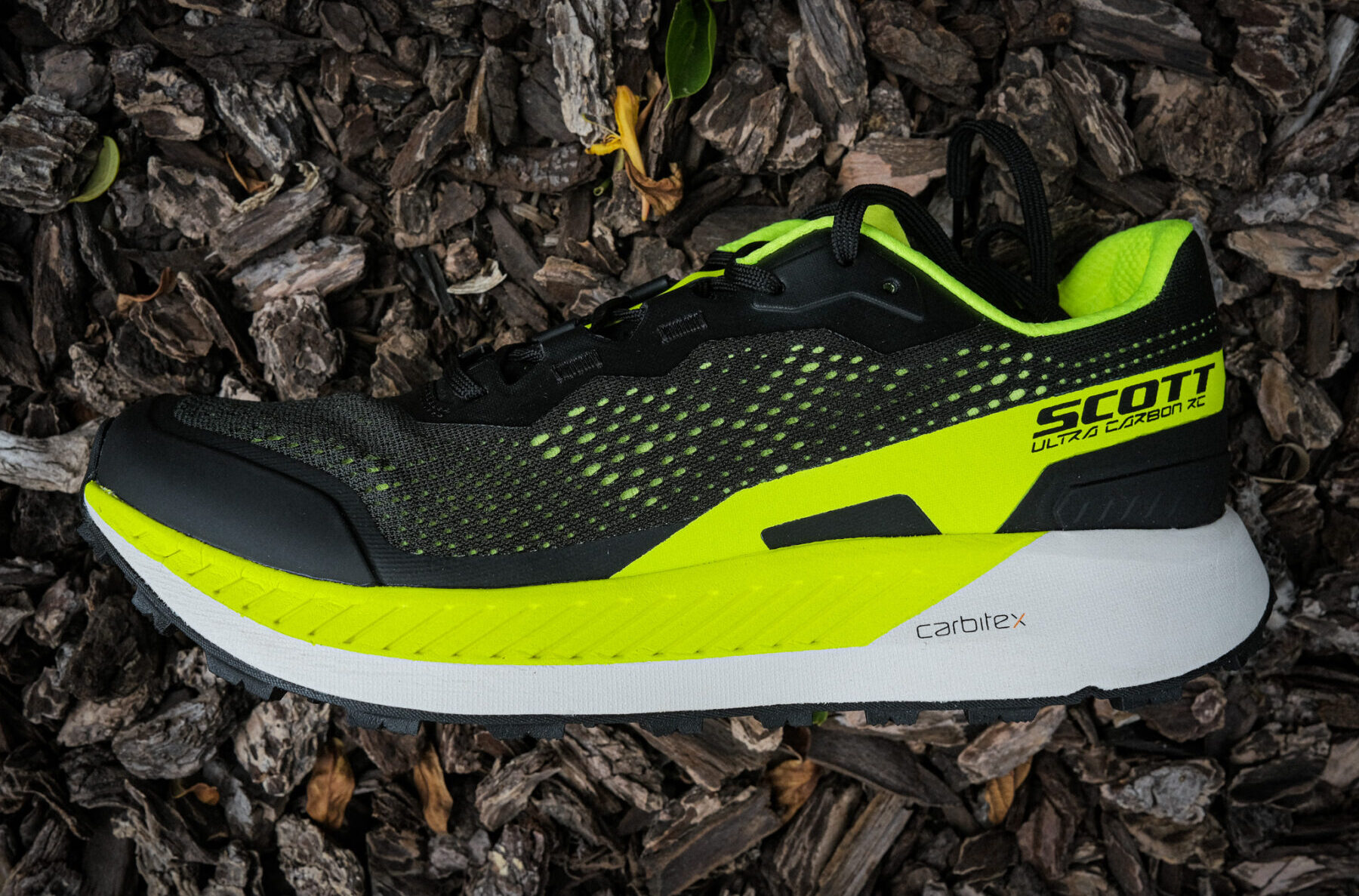
Fit & Features
A common denominator among carbon-plated trail shoes, at least the ones I’ve reviewed, has been their rigidity. From a propulsion standpoint, this makes sense. Maximum energy return is bolstered by having a shoe that acts as a stiff lever, and the inflexibility of performance plates provides that — but almost always at the expense of ground feel. Recognizing the value of ground feel in the context of trail running shoes, footwear brands have experimented with the design of their carbon plates, to mixed results.
Perhaps the most successful take comes from Carbitex, a company that makes flexible composites for myriad brands in the outdoor industry, including Speedland, Saucony, The North Face, and now Scott. Their recently released “GearFlex” carbon plate, which is featured in the Ultra Carbon RC, is unique in that its degree of stiffness (reportedly) responds to speed. At slower paces, the plate retains its flexibility, but once the intensity picks up, it becomes more rigid. Theoretically, the plate’s flexible property should allow for more stability on technical terrain where most folks will be forced to slow down. Scott also decided to shorten their plate, giving it a “swallow tail” shape that splits under the forefoot and toward the heel to boost lateral flex.
The Ultra Carbon RC’s Carbitex GearFlex carbon plate is just one part of deconstructing the shoe’s midsole. Scott also enlists their “Evolved Rocker 2” platform, designed to reduce heel striking and increase running efficiency, and their premium “Kinetic Light Foam,” a fairly dense material that gives the shoe its 25 mm / 20 mm of stack height. This arrangement (i.e., dynamic carbon plate, significant rocker geometry, and relatively hard midsole foam) is new to me, and after a few brief runs, I’m still having trouble finding appropriate models to compare the Ultra Carbon RC to. Whether that portends well for the shoe remains to be seen.
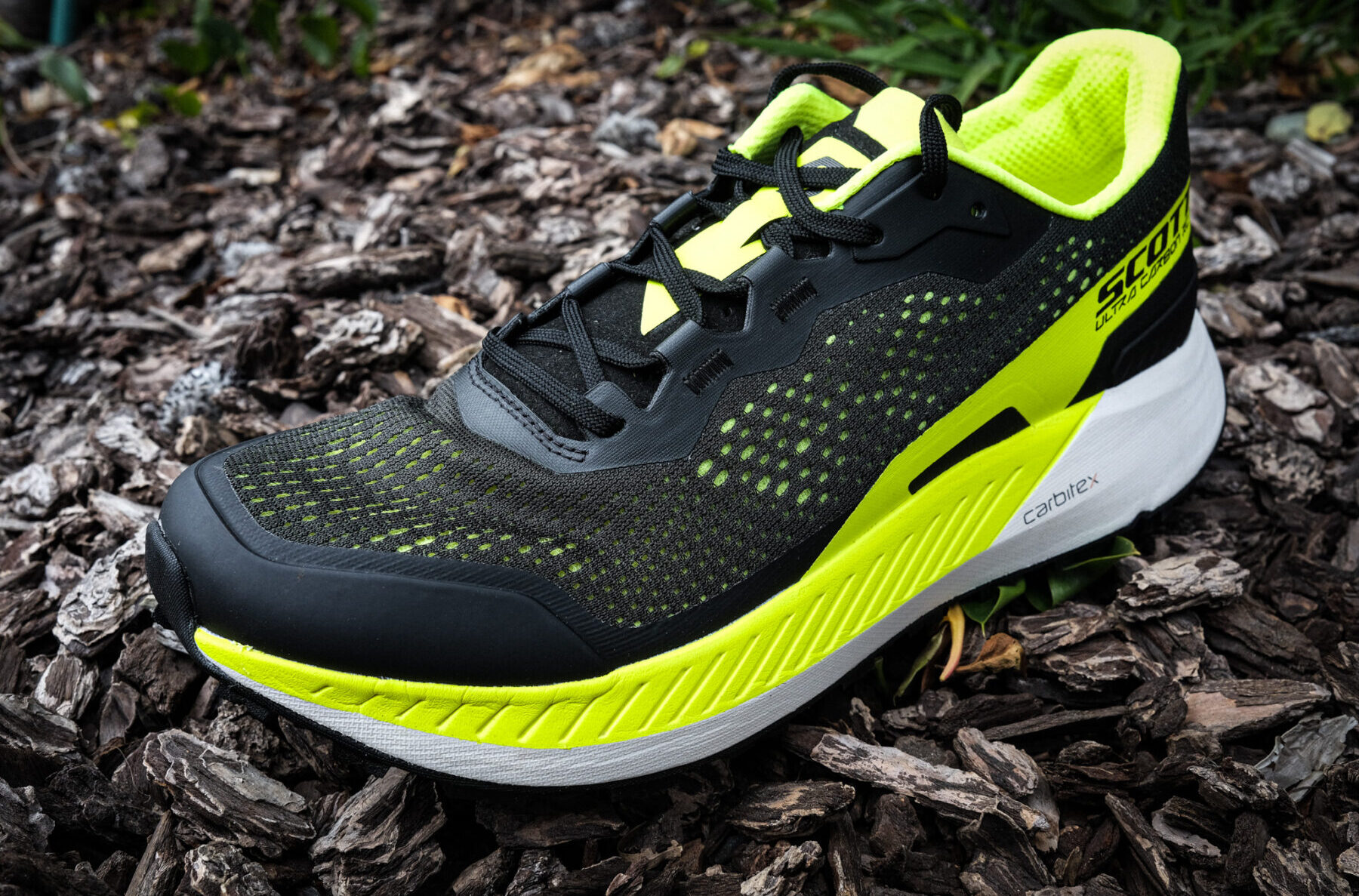
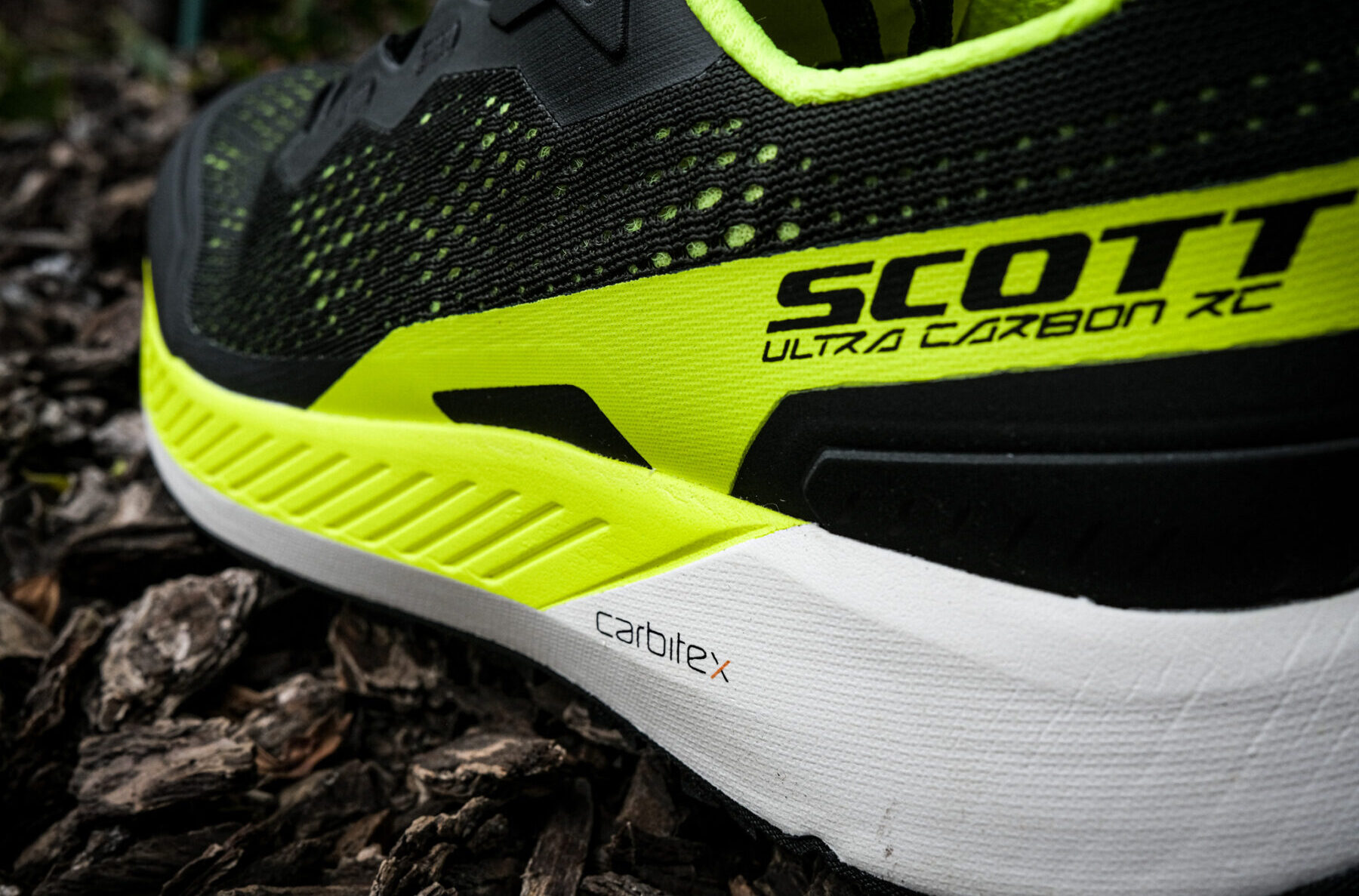
I think the Ultra Carbon RC will ultimately turn out to be a shoe that I quite enjoy, but I’m concerned that it’s slightly confused about what it wants to be. Scott positions the Ultra Carbon RC as a model fit for 100 miles (they relied heavily on input from ultrarunner Cody Lind, who helped design the shoe specifically for Western States), but, at least early on, it feels better suited for fast, short distances. However, the shoe’s weight complicates things even more. At 300 g for a US Men’s size 9, I’d consider it too heavy to compete with most trail racers currently on the market. For context, here’s how the Ultra Carbon RC’s stated weight compares to the stated weights for some other similar models. All weights are based on a US Men’s Size 9.
200 g / 7.05 oz — Nnormal Kjerag
247 g / 8.7 oz — Hoka Torrent 3
249 g / 8.8 oz — Hoka Tecton X 2
255 g / 9 oz — Naked T/r
255 g / 9 oz — Saucony Endorphin Edge
260 g / 9.2 oz — Nnormal Tomir
270 g / 9.5 oz — Salomon Pulsar Trail Pro
295 g / 10.4 oz — Hoka Mafate Speed 4
295 g / 10.4 oz — On Cloud Ultra
295 g / 10.4 oz — TNF Vectiv Flight
300 g / 10.6 oz — Scott Ultra Carbon RC
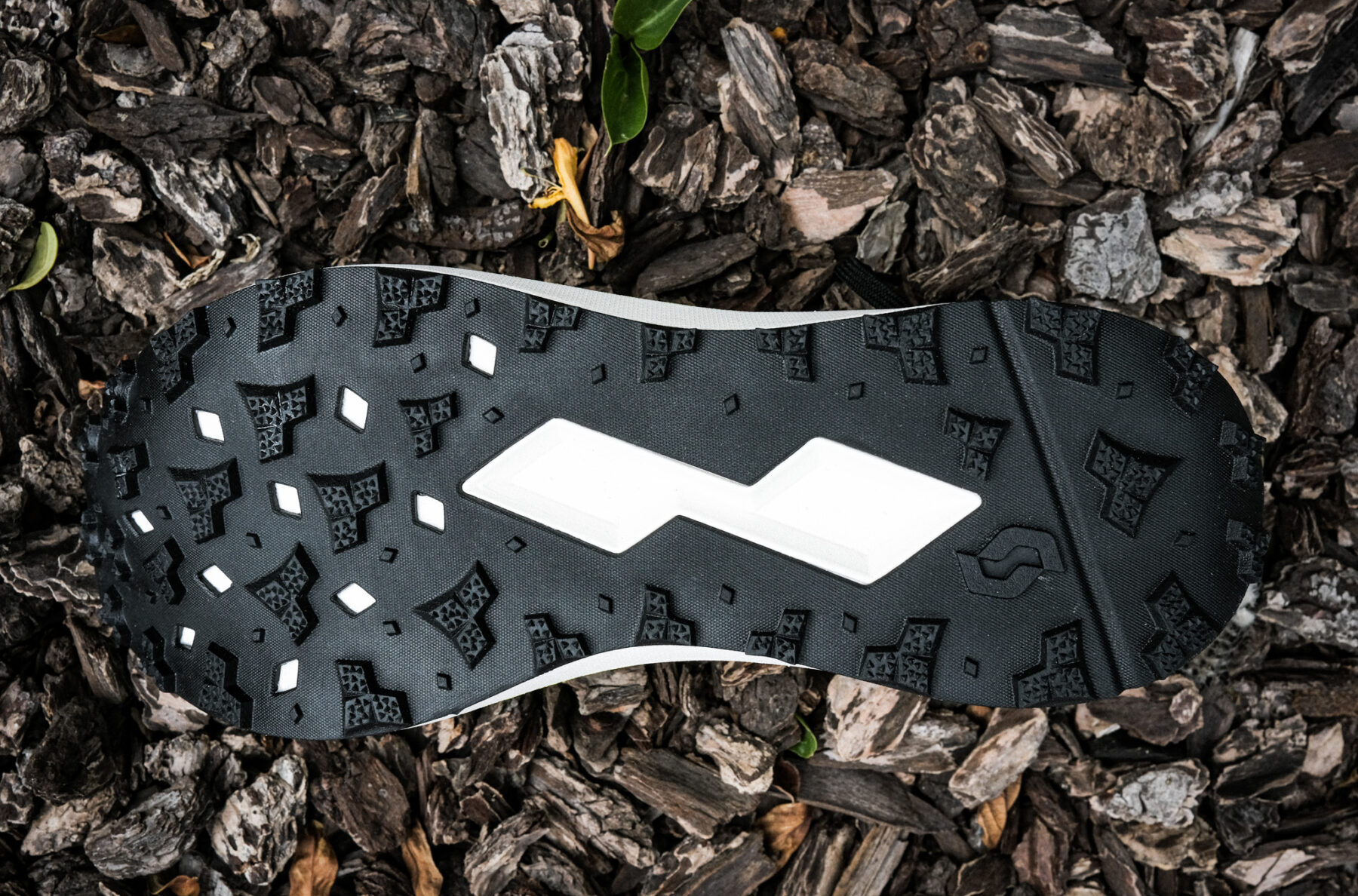
Things We’re Curious About
- My guess is that the Ultra Carbon RC will require significantly more break-in time than shoes without a performance plate / dense midsole foam. How long will that process take? And once broken in properly, will the Ultra Carbon RC feel more attuned to long distances?
- Carbon-plated trail shoes risk forgoing stability for energy return. To what extent is the Ultra Carbon RC guilty of this?
- Even though $230 is around the median price for trail shoes in the Ultra Carbon RC’s max-performance category, it’s still an unbelievable sum of money for a pair of shoes. While I suppose price shouldn’t necessarily reflect durability, I’m curious about how many miles I’ll be able to get out of the shoe before retiring it.
Bottom Line (For Now)
The Ultra Carbon RC feels like the end product of a meticulously conceived concept. Scott pours an indulgent amount of resources into the shoe, but it’s headlined by an innovative carbon plate that reportedly adjusts its rigidity in response to speed and flexes dynamically to retain ground feel. Whether this design can rescue the Ultra Carbon RC from the stability issues that have sunk plated trail shoes in the past remains to be seen. Early miles point to a favorable outcome, but also call into question disparities between the Ultra Carbon RC’s intended purpose as an ultra-distance shoe and its practical leanings toward a fast, short-distance option. Keep an eye out for our forthcoming full review soon.
FULL REVIEW
Intro
Trail running shoes are likely not the first thing to spring to mind when you think about Scott. The legacy outdoor brand supports an immensely diverse product line, with fingers in industries as disparate as motorsports and freeskiing. Lately, their name carries perhaps the most currency in the cycling world, where their continued innovation has yielded an impressive stable of mountain and road bikes alike. However, Scott has been making high-performance running footwear since 2006, and within the last few years have steered further into the trail space. Materially, they’ve continued to expand their offerings by updating existing trail shoes while working with some of their sponsored athletes to develop new models.
Fit
Similar to trail shoes with maximal stack heights (> 33 mm) that are forced to adopt countermeasures to help right their tall platforms, models with performance plates must contend with the consequences of including inflexible panels in their midsoles. In several respects, how footwear brands decide to do this often dictates the shoe’s entire fit, and Scott’s approach to the Ultra Carbon RC is definitely a prime example of this.
Scott shoes generally run on the narrow side, and while the Ultra Carbon RC is intended to be a bit more spacious than some of their other models, considering its aspirations as a long-distance option, it definitely favors slim feet. There’s aggressive arch support both medially and laterally, and while the toe box does flare out to some degree in the forefoot, I still wouldn’t call it high volume. To round things out, a gusseted tongue is put in place to wrap the foot for added security, a detail that I think is pretty indispensable on a shoe that will be expected to handle more energy return than models without a plate. I’d also note that the Ultra Carbon RC runs true to size. For context, the Ultra Carbon RC and other Scott models I’ve tested are generally similar fit-wise to popular Salomon models like the Salomon Pulsar Trail Pro.
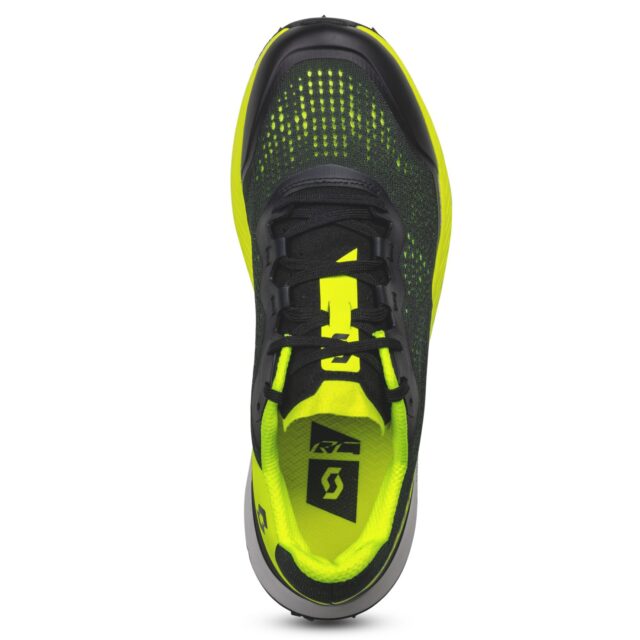
Digging out the lead I may have just buried, I think the most divisive part of the Ultra Carbon RC will be its “Evolved Rocker 2” platform. Many trail models now incorporate this sort of rockered platform, namely to reduce heel striking and increase running efficiency. Rockered midsoles are typically seen on shoes with high stack heights. Having added cushion underfoot helps soften and smooth out the rockered platform’s roll when running. The Ultra Carbon RC has a pretty modest stack height at 25 mm / 21 mm, and its plated midsole construction is incredibly rigid by nature. As a result, the shoe’s Evolved Rocker 2 came across as overbearing and harsh at times, constantly wanting to launch my foot forward regardless of pace / terrain. While that may sound like something you’d want from a shoe, I’ll explain in the “On Trail” section of this review why that impulse isn’t always wanted.
I previously commented that putting on the Ultra Carbon RC for the first time felt like surrendering agency to it, and I still feel the same way 40 miles in. The shoe’s fit doesn’t leave a ton of room for adjustments, nor has it shifted around all that much over time (so far). For folks with slender-to-average-width feet and normal-to-high arches, this will likely be a welcomed characteristic; however, for those of us with feet not naturally suited for the Ultra Carbon RC’s last, I wouldn’t expect the shoe’s fit to budge in any significant way even when properly broken in.
Weight
One of my favorite ways to discern a shoe’s intended purpose is to look at its weight. Outsole design, stack height, and heel-to-toe drop can divulge a lot of useful information, sure, but I’d contest that the scale speaks more directly to how a model should be used. At 300 g for a US Men’s size 9, the Ultra Carbon RC’s weight seems to contradict both what Scott has in mind for it as an ultra-distance racing option and my own opinion that it’s a shoe more appropriate for fast, short distances. For context, here’s how the Ultra Carbon RC’s stated weight compares to the stated weights of models from both categories. All weights are based on a US Men’s Size 9.
200 g / 7.05 oz — Nnormal Kjerag
247 g / 8.7 oz — Hoka Torrent 3
252 g / 8.9 oz — Hoka Tecton X 2
255 g / 9 oz — Naked T/r
255 g / 9 oz — Saucony Endorphin Edge
260 g / 9.2 oz — Nnormal Tomir
270 g / 9.5 oz — Salomon Pulsar Trail Pro
295 g / 10.4 oz — Hoka Mafate Speed 4
295 g / 10.4 oz — On Cloud Ultra
295 g / 10.4 oz — TNF Vectiv Flight
295 g / 10.4 oz — On Cloudultra
300 g / 10.6 oz — Scott Ultra Carbon RC
300 g / 10.6 oz — Inov-8 Trailfly G 300
309 g / 10.9 oz — The North Face Enduris II
312 g / 11 oz — Brooks Caldera 6
312 g / 11 oz — Saucony Endorphin Trail
317 g / 11.2 oz — Altra Mont Blanc BOA
320 g / 11.3 oz — New Balance Fresh Foam X More Trail v3
Caught between carbon plated trail racers and maximalist options, the Ultra Carbon RC’s weight leads to some confusion. Scott forgoes a lot of gram-saving strategies commonly used by premium models, like segmented outsoles and single-layer uppers, two interventions that could have easily lightened the Ultra Carbon RC. However, these tweaks don’t help the heft of the shoe’s midsole. Its Kinetic Light Foam feels like one of the denser (i.e., heavier) foam composites I’ve tested, and while it is made out of lightweight carbon fiber, the shoe’s Carbitex plate brings additional grams that may not offset its added energy return. Some shoes run lighter than they actually are. The Ultra Carbon RC is not one of them.
Upper
I just finished speculating that a lot of the Ultra Carbon RC’s weight is confined to its midsole, and my justification for that lies in how minimal its upper is. A lightweight, perforated layer of engineered mesh on top of a soft, thin inner liner provides the only structure for a toe box that’s rounded but not quite as squared off as what’s seen on models from Altra / Topo Athletic. It’s somewhat stretchy and breathed / drained really well.
Moving back toward the midfoot, a gusseted, racer-style tongue that’s wider than average helps wrap the foot beneath traditional laces. Outside of a thin TPU toe rand, there’s really not much in the way of protection. I’m generally a fan of uppers that do more with less, so I enjoyed these aspects of Ultra Carbon RC’s. The shoe’s inherent inflexibility will likely spare the upper material from excessive creasing, too, so while it’s definitely not the most protective design (which is ok, considering the Ultra Carbon RC’s preference for non-technical trails) it likely shouldn’t affect its durability.

The functional design that Scott applies to the front of the Ultra Carbon RC’s upper had trouble translating to the back of the shoe, in my opinion. The ankle and heel collar, while minimally padded, are quite thin and stiff. They both did a fine job of securing my foot, but on longer efforts (> 90 minutes), the top of the ankle collar began to irritate my malleolus. And the heel collar, which is similarly rigid and angled in slightly, rubbed up against my Achilles. Again, the choice not to outfit the Ultra Carbon RC with more forgiving materials, a better match for long-distance models, makes me question how intact the shoe’s identity is. If it’s any consolation, I do think the build quality from Scott is top notch and collectively helps the Ultra Carbon RC feel otherwise pretty comfortable on foot.
Midsole
A common denominator among carbon-plated trail shoes, at least the ones I’ve reviewed, has been their rigidity. From a propulsion standpoint, this makes sense. Maximum energy return is bolstered by having a shoe that acts as a stiff lever, and the inflexibility of performance plates provides that — but almost always at the expense of ground feel. Recognizing the value of ground feel in the context of trail running shoes, footwear brands have experimented with the design of their carbon plates, to mixed results.
Perhaps the most successful take comes from Carbitex, a company that makes composites for myriad brands in the outdoor industry, including Speedland, Saucony, The North Face, and now Scott. Their recently released “GearFlex” carbon plate, which is featured in the Ultra Carbon RC, is unique in that its degree of stiffness (reportedly) responds to speed. At slower paces, the plate is supposed to retain its flexibility, but once the intensity picks up, it’s designed to become more rigid. Theoretically, the plate’s flexible property should allow for more stability on technical terrain where most folks will be forced to slow down. Scott also decided to shorten their plate, giving it a “swallow tail” shape that splits under the forefoot and toward the heel to boost lateral flex. Candidly, I had a hard time differentiating between the plate’s different states and didn’t get a sense for its improved flexibility compared to models with full-length performance plates I’ve tested in the past. From a propulsion standpoint, the Ultra Carbon RC’s rocker seemed to have more of an impact on my running efficiency than any other part of the shoe.
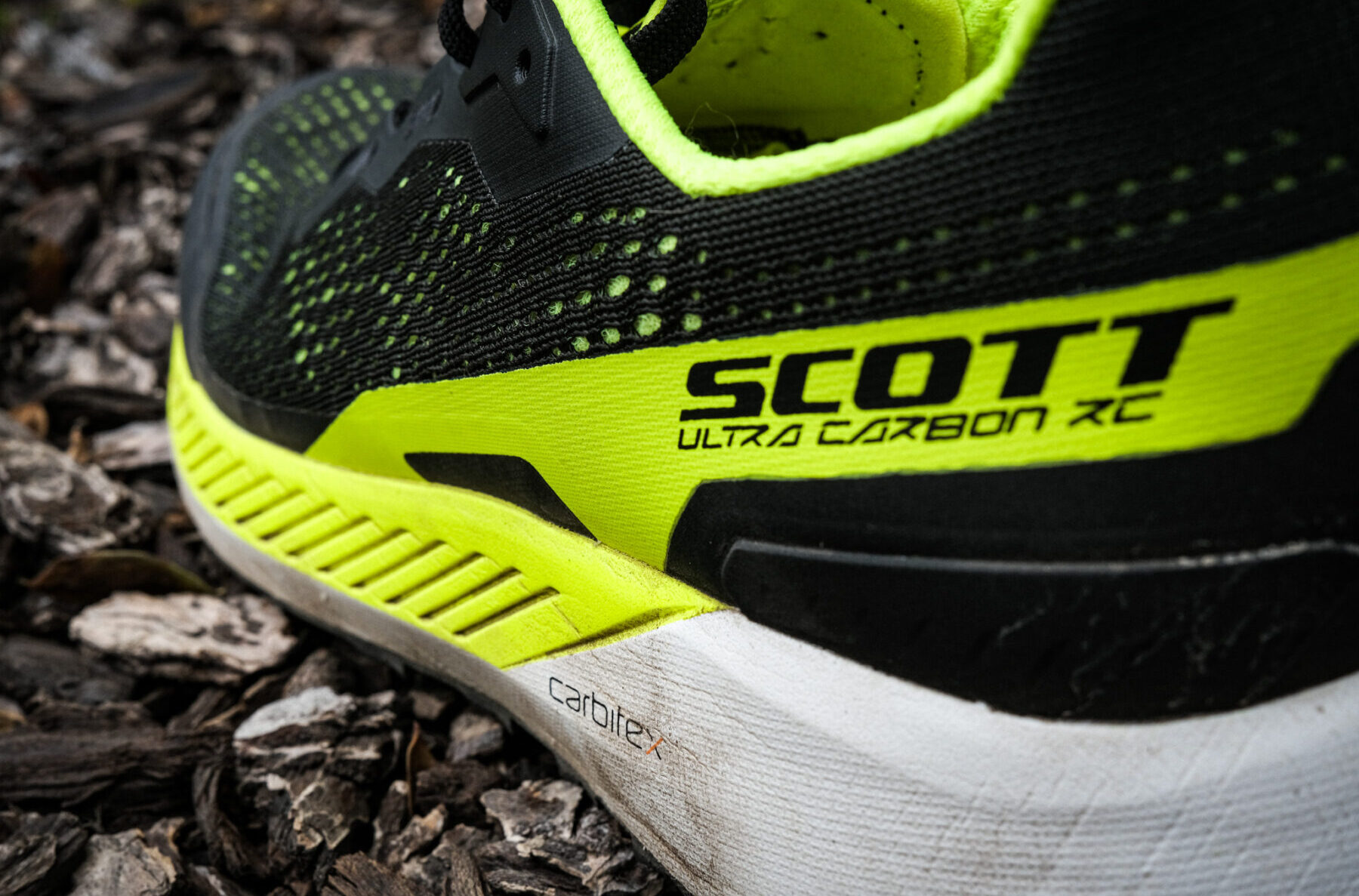
The Ultra Carbon RC’s Carbitex GearFlex carbon plate is just one part of deconstructing the shoe’s midsole. Scott also enlists their Evolved Rocker 2 platform, designed to reduce heel striking and increase running efficiency, and their premium Kinetic Light Foam, a dense material that gives the shoe its 25 mm / 20 mm of stack height. This arrangement (i.e., dynamic carbon plate, significant rocker geometry, and relatively hard midsole foam) shares a similar design and purpose with the Craft CTM Ultra Carbon Trail, though the latter has 40 mm of stack height and feels softer underfoot. The firmness that defined the Ultra Carbon RC’s midsole early on has yet to subside, leaving the shoe feeling blunt and devoid of almost all energy return. I think pairing dense Kinetic Light Foam with a carbon plate, even one that’s supposed to be dynamic, is a bit of a misstep. If Scott had used a lighter EVA compound with a lower durometer (i.e., hardness), I think the Ultra Carbon RC would be helped by the gentler, livelier midsole material of that type could provide.
The amount of technical jargon Scott includes in the Ultra Carbon RC’s long list of stated features inflated my expectations of what running in the shoe would actually feel like. As someone who’s usually incredulous when it comes to this kind of promotion, I admit that I largely bought into the idea that Scott had developed the Ultra Carbon RC to be different from the carbon-plated trail models I’ve reviewed in the past. At this point in testing, I don’t think the shoe has fully realized that. If anything changes down the road, I’ll chime back in with an update.
Outsole
Scott reportedly worked with ultrarunner Cody Lind to design the Ultra Carbon RC specifically for Western States, a 100-mile race that’s known to favor “runners” (as opposed to more mountainous ultras where the advantage more often than not goes to strong hikers). Its course descends from Tahoe, CA to Auburn, CA via rolling singletrack that mainly consists of dry, hard-pack dirt. To contend with this terrain, Scott gave the Ultra Carbon RC what they call their “Ultra Traction” outsole, a full-length rubber tread with a number of large, triangle-shaped lugs arranged in a semi-radial design. The lugs closer to the perimeter of the shoe angle outward while those under the forefoot face forward.
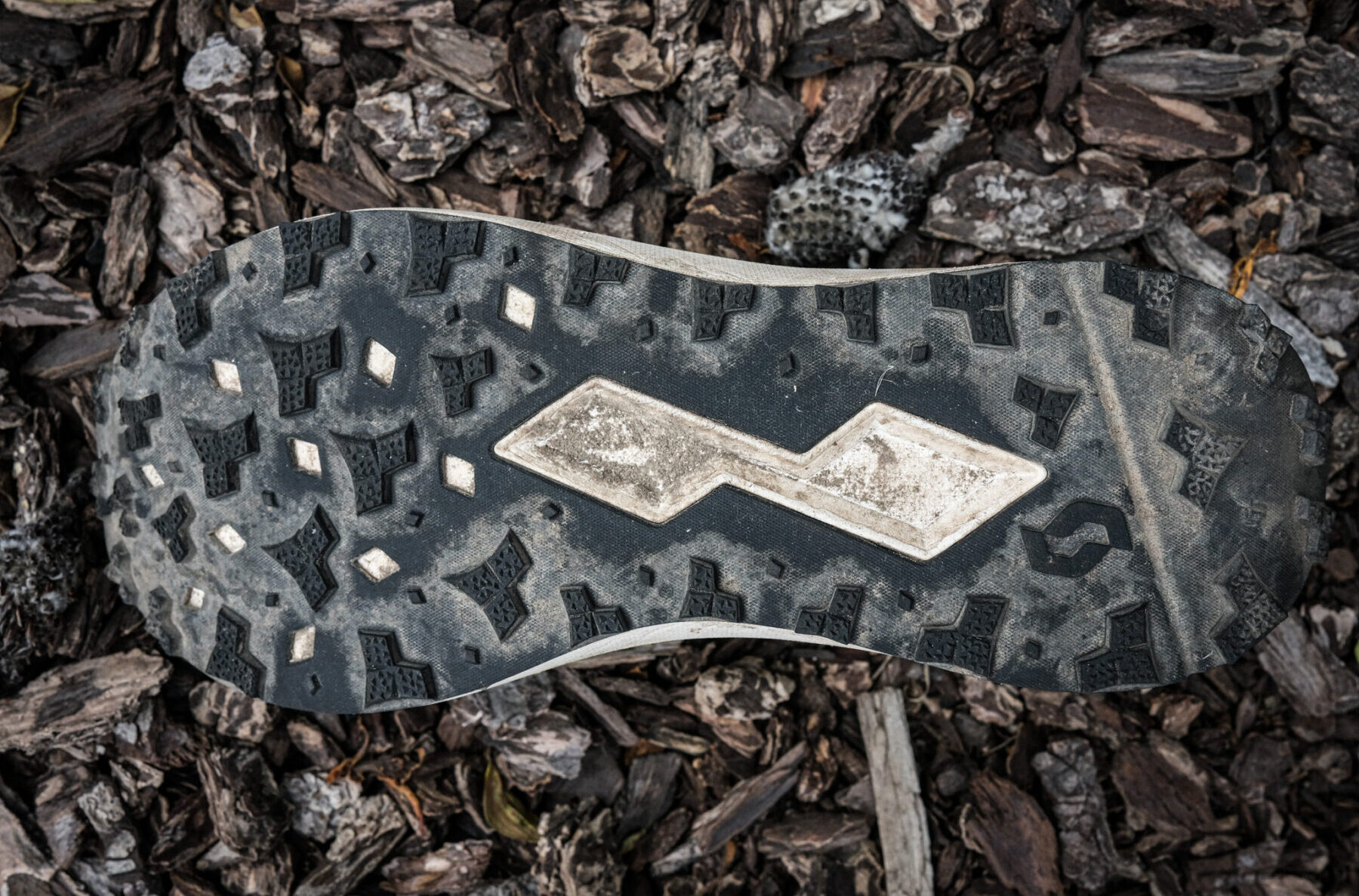
On Trail
Testing the Ultra Carbon RC, I was conscious not to treat it like a model for everyday training. Instead, I reserved the shoe mainly for workouts on rolling non-technical terrain (hence why my mileage is a bit lower than what I’d typically put on a model before reviewing it). The Marin Headlands north of San Francisco, with their expansive system of fire roads and punchy climbs, paired well with the Ultra Carbon RC’s strengths. The shoe’s platform felt stable enough in these scenarios. Its rockered shape nudged my foot off the ground quickly, and I do think I sensed increased energy return while running at faster paces from the dynamic carbon plate, however subtle. The average distances I ran — between 10 and 12 miles in total — were also not enough to leave my feet feeling too beat up from the midsole’s lack of cushioning. And while I’ve been critical of how inflexible the Ultra Carbon RC is, its rigidity helped power me up climbs and accelerate on flat sections of trail. On tired legs, the Evolved Rocker 2 platform acted as a crutch to keep me moving forward, like a form of inertia.
As I stacked up runs in the Ultra Carbon RC, the settings in which I found it thrived began to suffer from over-specificity. The list of things that I didn’t feel comfortable doing in the shoe vastly outnumbered the things I did. Even with a “dynamic” plate, the Ultra Carbon RC still lacked enough ground feel to safely navigate technical terrain, so that was off limits; its lack of cushioning and irritating heel collar meant that I had to keep most of my runs on the shorter side timewise; and its weight deterred me from using it for interval work. There were times that the shoes’ premium parts gelled together, but those brief streaks were often interrupted by one of the shortcomings listed above. Scott is definitely onto something with the Ultra Carbon RC, but as is often the case with first iterations of a model, there’s still plenty of room for refinement, particularly as it relates to the shoe’s midsole and intended purpose. I’ll be buying stock in Scott’s line nonetheless with high hopes for future versions of the Ultra Carbon RC.
Durability
One of the arguments against pricing carbon-plated trail shoes like clipless cycling shoes – a false-equivalence that companies like Speedland have made to justify $375 price tags – is that, on average, trail shoes last nowhere near as long. I’ve had the same pair of cycling shoes since 2016; I can’t even begin to speculate on how many pairs of trail shoes I’ve run through over that span of time. This holdup begs the question: “If I’m paying upwards of $250 for a trail shoe, is part of what I’m paying for increased durability? What’s a realistic number of miles I should expect to get out of a high-end model I paid a ton of money for?”
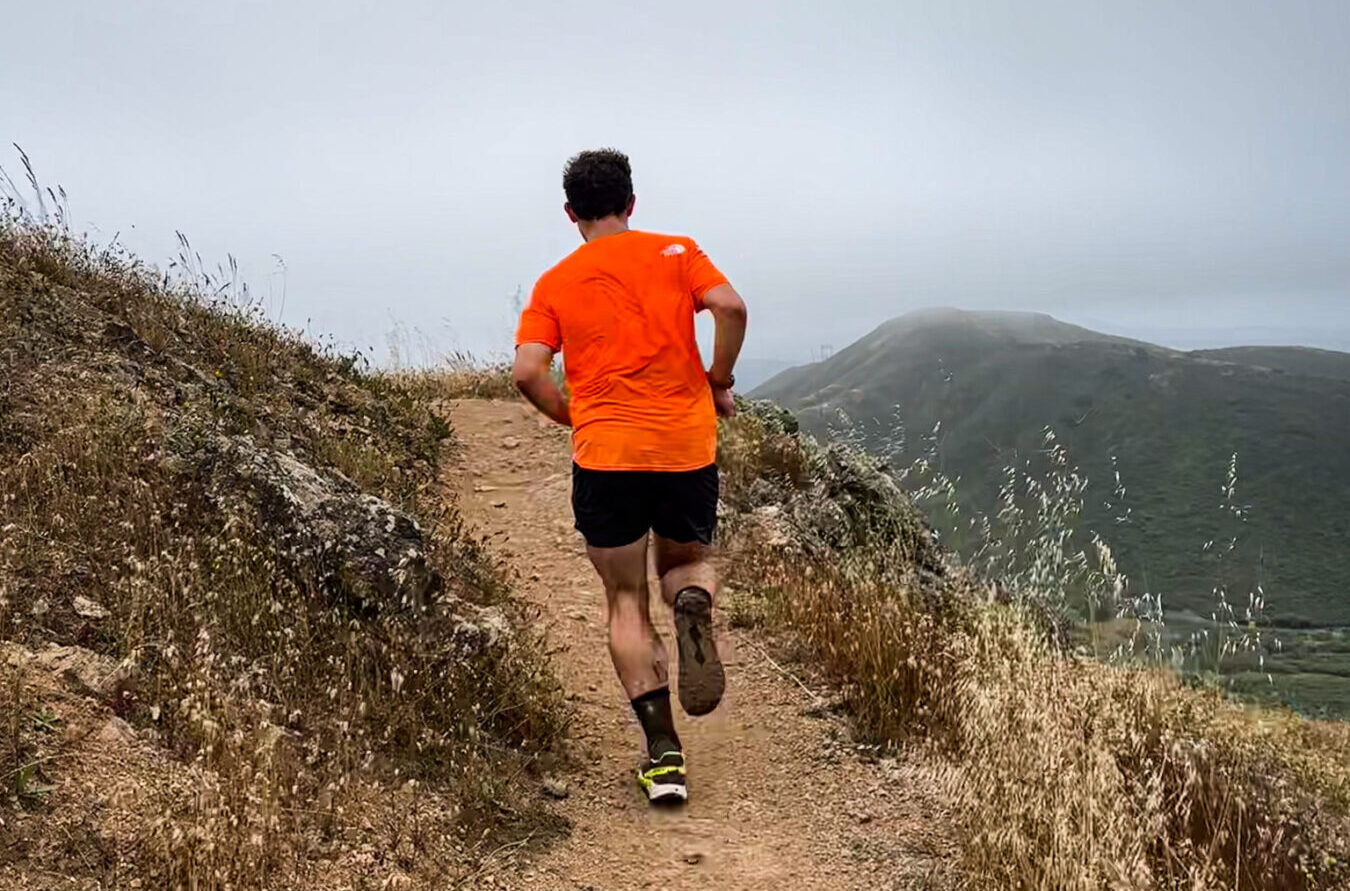
Who’s It For?
The carbon-plated performance trail shoe category is the niche of the niche, so the Ultra Carbon RC’s audience is predictably small. Narrowing that cohort down even further, I think a general prerequisite for folks who could benefit from the shoe is a desire to run fast, likely in a competitive setting. The Ultra Carbon RC is far from an everyday trainer or dedicated long-run option and closer to a race- / workout-specific model. Scott’s conception of the shoe aligns with that thinking, for the most part. Where I begin to separate from their thinking begins with the Ultra Carbon RC’s ambitions as a 100-mile option. In my opinion, the shoe’s rigid midsole and harsh ride disqualify it from achieving that distance for pretty much everyone outside of elite runners. While that sounds like a major disappointment, shortening the shoe’s range is actually pretty insignificant in the grand scheme of things.
Most folks I know, myself included, seldom run more than 25 miles at a time consistently, and for runs on non-technical terrain at and below that distance, I think the Ultra Carbon RC is a qualified option. Transitioning to it from an ultra-plush maximal shoe might take some adjusting, and runners with wide feet might feel starved of room through the arch, but if the Ultra Carbon RC fits your foot and you grant it some patience to fully break in, I think you’ll be rewarded.
Bottom Line
The Ultra Carbon RC feels like the end product of a meticulously conceived concept. Scott pours an indulgent amount of resources into the shoe, but it’s headlined by an innovative carbon plate that reportedly adjusts its rigidity in response to speed and flexes dynamically to retain ground feel. While its intended purpose as an ultra-distance shoe doesn’t always align with its practical performance as an option that prefers shorter distances, the Ultra Carbon RC helps advance the relatively new carbon-plated performance trail shoe category by innovating on form and correcting some of the instability that has plagued plate models of the past.

